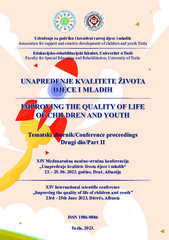Govorno-jezička terapija i kognitivna rehabilitacija u tretmanu vaskularne demencije
Speech-language therapy and cognitive rehabilitation in the treatment of vascular dementia
| dc.creator | Vuković, Mile | |
| dc.creator | Vasilijević, Slavica | |
| dc.date.accessioned | 2023-08-14T07:38:06Z | |
| dc.date.available | 2023-08-14T07:38:06Z | |
| dc.date.issued | 2023 | |
| dc.identifier.issn | 1986-9886 | |
| dc.identifier.uri | http://rfasper.fasper.bg.ac.rs/handle/123456789/5264 | |
| dc.description.abstract | Vaskularna demencija nastaje nakon cerebrovaskularnih oboljenja, tj. infarkta mozga. Karakteriše se padom i progresijom kognitivnih funkcija, uključujući i jezik. Po učestalosti nalazi se odmah iza Alchajmerove demencije. U tretmanu pacijenata sa vaskularnom demencijom koriste se farmakološki i nefarmakološki oblici terapije. Pored drugih, nefarmakološke oblike terapije čine govorno-jezička terapija i kognitivna rehabilitacija. Budući da pacijenti s vaskularnom demencijom ispoljavaju različite simptome poremećaja jezičkih funkcija, govorno- jezička terapija zauzima važno mesto u tretmanu ovih pacijenata. Pokazuje se da ovaj metod terapije doprinosi usporavanju progresije jezičkog poremećaja i održavanju komunikativnih sposobnosti u dužem vremenskom intervalu. Takođe je pokazano da se mnogi terapijski zadaci koji se koriste tokom govorno-jezičke terapije mogu koristiti i u postupku kognitivne rehabilitacije. Takav pristup tretmanu doprinosi boljem kognitivnom funkcionisanju osobe u svakodnevnim životnim aktivnostima. | sr |
| dc.description.abstract | Vascular dementia arises after cerebrovascular diseases, i.e. stroke. It is characterized by the decline and progression of cognitive functions, including language. In terms of frequency, it is right behind Alzheimer's dementia. In the treatment of patients with vascular dementia, pharmacological and non-pharmacological forms of therapy are used. Among others, non- pharmacological forms of treatment include speech-language therapy and cognitive rehabilitation. Speech-language therapy is essential in the treatment of patients with vascular dementia since they demonstrate various symptoms of language function disorders. It has been shown that this treatment method contributes to slowing the progression of language disorder and maintaining communicative abilities over a more extended period. Many therapeutic tasks used in speech-language therapy have also been shown to be useful in the cognitive rehabilitation process. Such an approach to treatment contributes to a person's better cognitive functioning in everyday life activities. | sr |
| dc.language.iso | sr | sr |
| dc.publisher | Udruženje za podršku i kreativni razvoj djece i mladih Association for support and creative development of children and youth Tuzla | sr |
| dc.publisher | Edukacijsko-rehabilitacijski fakultet, Univerzitet u Tuzli Faculty for Special Education and Rehabilitation, University of Tuzla | sr |
| dc.relation | “Евалуација третмана стечених поремећаја говора и језика”, Br 179068 | sr |
| dc.rights | openAccess | sr |
| dc.rights.uri | https://creativecommons.org/licenses/by-nc-nd/4.0/ | |
| dc.source | Unapređenje kvalitete života djece i mladih,Tematski zbornik | sr |
| dc.subject | vaskularna demencija | sr |
| dc.subject | govorno-jezička terapija | sr |
| dc.subject | kognitivna rehabilitacija | sr |
| dc.subject | vascular dementia | sr |
| dc.subject | speech-language therapy | sr |
| dc.subject | cognitive rehabilitation | sr |
| dc.title | Govorno-jezička terapija i kognitivna rehabilitacija u tretmanu vaskularne demencije | sr |
| dc.title | Speech-language therapy and cognitive rehabilitation in the treatment of vascular dementia | sr |
| dc.type | conferenceObject | sr |
| dc.rights.license | BY-NC-ND | sr |
| dc.citation.epage | 306 | |
| dc.citation.spage | 301 | |
| dc.identifier.fulltext | http://rfasper.fasper.bg.ac.rs/bitstream/id/10664/bitstream_10664.pdf | |
| dc.identifier.rcub | https://hdl.handle.net/21.15107/rcub_rfasper_5264 | |
| dc.type.version | publishedVersion | sr |


